A Business Model for Independent Music Teachers
Throughout history, people have learned to work together and to cooperate for mutual benefit. In ancient times, communities cooperated in gathering food, building shelters, hunting and fishing. During the colonial era, people worked together in planting and harvesting crops, sharing equipment and building storages.
During the nineteenth century, the Industrial Revolution propelled notions of co-operation into the realms of business as middleclass workers saw a decline in wages, lengthening workdays and deteriorating working conditions.
Amid growing poverty arose the first enduring co-operative enterprise, the Rochdale Equitable Pioneers Society, formed in 1844 by a band of twenty-eight English textile workers eager to earn better wages and make a better life working together.
Through principles of autonomy and independence, democratic member control, member economic participation, education, training and concern for the community, the Rochdale Pioneers established a successful business model that continues today throughout the world in industries of finance, housing, energy, agriculture, education and many others.
In the music industry, the co-operative business model already exists in Canada, Australia and the United Kingdom where it is commonly referred to as a “music education co-operative.”
These co-operatives provide members with shared pedagogical, professional and financial resources that help create sustainable and profitable opportunities as independent music educators.
Like the Rochdale Pioneers, many challenges face modern independent music teachers, like costly commission fees, competitive job markets, restrictive contractual agreements, rapidly changing technology and a general lack of entrepreneurial training.
This article presents two types of music teacher co-operatives, the home studio co-operative and the music school co-operative, each uniquely suited to empowering independent music teachers with effective advertising, marketing, collective branding, purchasing power and organizational support.
There has never been a better time for musicians to begin an independent music-teaching career, and music teacher co-operatives help make it a reality by offering higher wages, autonomy and collaboration. It’s time for music teachers to work together, not for someone else.
A Profitable Aim
A growing trend is for music teachers to pursue contract-teaching employment with music schools rather than self-employment through a home studio.
Some music teachers choose to work for music schools for the benefits of administrative ease, sustainable student-flow, established credibility, extensive marketing and advertising, comprehensive program offerings, and access to studio space and equipment.
But the disadvantages of music school teaching rest in the contract-teaching model, which often necessitates a commission fee of between 20 and 50 percent, costing teachers thousands of dollars each year.
The financial justification given for such commission fees is that contract teachers are still able to earn an hourly wage of between $20 and $30. Meaning, if contract teachers are paid $60 per hour, then a 50% commission fee only reduces their hourly wage to $30.
But the principle of “market valuation” challenges this notion by exposing inherent economic problems within the contract music-teaching model. Independent music teaching salaries depend largely on demography of clientele and relative geography.
To illustrate this principle, take, for example, the same hourly wage of $60 and multiply it by 25 hours, a week’s worth of teaching for many music teachers. The total becomes $1,500.
Next, take the weekly wage of $1,500 and multiply it by 44 weeks, an average number of teaching weeks for many independent music teachers. The total is $66,000.
Now, apply an average tax rate of 20% to these gross earnings and the net annual income becomes $52,800. So, hypothetically, a self-employed independent music teacher could earn $52,000 per year teaching 44 weeks of the year for 25 hours each week.

Now compare the same gross earnings of $66,000 after paying commission fees of 25, 35 and 45 percent:

This table illustrates that depending on commission fees, contract music teachers may earn $23,000 less per year while paying a 45% commission fee, $18,000 less per year while paying a 35% commission fee and $13,000 less per year while paying a 25% commission fee.
As these losses are compounded by five and ten years of paying commission fees, the totals easily become tens of thousands of dollars in lost income. In the case of a 45% commission fee paid over ten years, the resulting loss of income is in excess of $200,000.
In spite of these losses, however, the justification made by employers is that most contract music teachers still earn an hourly wage of between $25 and $30. Therefore, a contract music teacher working 40 hours per week at these rates could feasibly earn between $40,000 and $50,000 per year.
But the music teaching market has not valued private music instruction at $20 to $30 per hour for many reasons. First of which because most independent music teachers are unable to teach 40 hours per week, as the common teaching times are limited to after-school hours and evenings.
Therefore working an average week of 25 hours, instead of 40, negates hourly pay of $25 to $30, and actually reduces its weekly total to that of a 40-hour week of $15 to $18 per hour.
Secondly, most independent music teachers do not work 52 weeks out of the year because the majority of their students only take lessons throughout the school year, breaking frequently for holidays and vacations.
As a result, most independent music teachers teach on average between 34 and 44 weeks per year, again, meaning that $25 to $30 per hour is not all that it seems.
To put this in perspective, consider that contract music teachers earning $25 per hour and working 25 hours per week for 40 weeks will earn just over $20,000 per year after paying estimated taxes of 20%.
This unfortunate reality illustrates why the music teaching market has not valued music lessons at $25 or $30 per hour but often at $40 to $60 per hour.
Like the textile workers of the Industrial Revolution who endured low wages to the point of poverty, so are music teachers who suffer costly commission fees through contract music teaching.
Two Types of Music Teacher Co-operatives
I will describe two types of music teacher co-operatives. First, the Home Studio Co-operative, which primarily functions as an advertising and marketing mechanism with unified branding, purchasing power and professional support, and secondly, the Music School Co-operative, which offers shared teaching space in addition to the benefits of the first type.
In both types, members govern co-op expansion, regulate new student-distribution, determine contribution amounts and fund allocation, and establish strategic vision.
The Home Studio Co-operative
In 2013, I established a Home Studio Co-operative in the saturated music teaching market of Greenville, South Carolina, where there already existed numerous music schools and a host of independent music teachers.
My co-op began rather unintentionally in the spring of 2013 as I concluded my second year of full-time teaching. I had a studio of about fifty students, but the upcoming fall semester was bringing significant change for my studio and me.
That fall, I was beginning doctoral work in piano pedagogy at the University of South Carolina, so I decided to reduce my teaching load from fifty to thirty students.
I didn’t want to arbitrarily cut twenty students from my studio, refer them to another teacher and wipe my hands clean. I also didn’t want to hand them over to another teacher and simply charge a commission fee. I had witnessed too many college music graduates frustrated in contract-teaching positions.
I loved being a self-employed music teacher. I valued the flexibility, the independence and the profits. All I really wanted was to help one other teacher enjoy a self-employed music-teaching career like mine.
So, I decided to collaborate with another teacher and form a music teacher co-operative, though at the time I had no idea what that meant.
I knew another teacher nearby who was ready to leave her job at a local music school as a contract teacher, so I told her my idea of starting a music teacher co-op, that I had twenty students ready to hand someone, and that I wanted it to be her.
I gave her the offer with no strings attached, no commission fees and no contract. In return, we would split all advertising and marketing costs for the upcoming year and I would add her to my website.
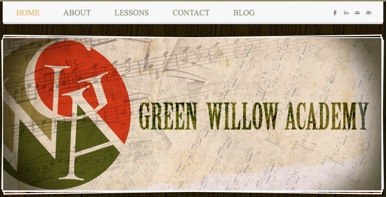
She agreed, so I immediately added her photo and biography to my (our) studio website (greenwillowacademy.com) and began including her in all advertising and marketing efforts.
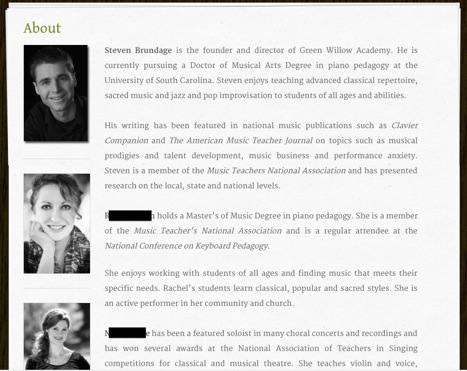
We decided to split the difference on website hosting and content management. My web designer, meadowsville.com, hosted our website for $70 per year and gave us content management $90 per year.
Hosting companies like GoDaddy.com, HostGator.com and Fatcow.com typically charge between $48 and $72 per year, and web builders like Wix.com, Volusion.com, Moonfruit.com and Wordpress.com frequently offer content management free of charge.
In spite of the higher cost, I enjoyed working with Meadowsville because they did everything for me: designed my website, logo and print ads, as well as provided content management and hosting.
For advertising, we split $90 for a one year listing on two online music teacher directories – Thumbtack.com and LessonRating.com. We paid $200 for three months of Google Adwords, an online advertisement campaign, perfect for a small business like mine.
Google Adword campaigns are highly customizable, affordable and effective. Users can target specific geographic regions, set monthly budgets and immediately begin reaching potential students. Users can also select precise times for their advertisements to appear on Google.
Ads appear based on imbedded keywords. This means that an ad for piano lessons would likely include keywords such as “piano lessons” or “piano teachers” in a particular region.
Google Adwords are paid for on a cost-per-click basis, meaning, users pay only when their advertisement has been clicked. Users set a daily budget and ads continue appearing until their daily budget has been met.
Ads are listed on Google search results according to a hierarchy of bid price. This means that an ad with the highest cost-per-click for its category will post highest on Google search results.
I often run ads for my co-op, which compete against ads by other music studios, with a cost-per-click bid price of $3.00 and a daily budget of $6.00. In my market, this means that my ads typically have the highest bid price, and consequently post first in Google search results.
I typically allow ads to run from May through August so to take advantage of parents searching for summer and back-to-school activities.
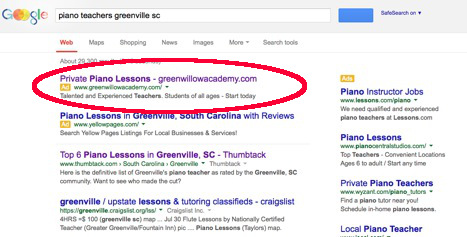
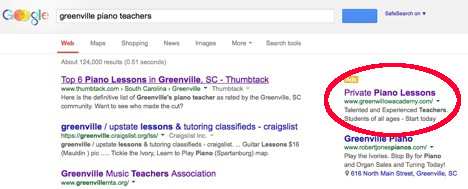
In addition to Google Ads, the most beneficial online advertising tool that my home studio co-operative utilized was improvements make to our website’s search engine optimization, more widely known as SEO.
SEO refers to the quality of a website’s search result ranking, meaning, if someone searches for “piano lessons in Greenville, SC,” the quality of my website’s SEO determines whether it appears on the first or the tenth page of search results.
Good SEO is vital to the growth of any music studio and is second only to word of mouth advertising.
Before improving my studio website’s SEO, it appeared somewhere between page eight and ten for Google search results for various permutations of “piano lessons” and “piano teachers” in Greenville, South Carolina.
The poor SEO performance showed in the low number of hits our website received on a monthly basis. Once I improved our website’s SEO, it brought our website from the ninth or tenth page of search results to the first in the span of a month.
After a few months, our website search result ranking equaled or surpassed all other music studios in our region. The results were astounding. We had a steady stream of new student inquiries through our website.
Improving your website’s SEO can be very expensive. Two marketing firms quoted me prices of $170 and $500 per month for their services. These prices were outside our budget, so I began reading and experimenting on my own.
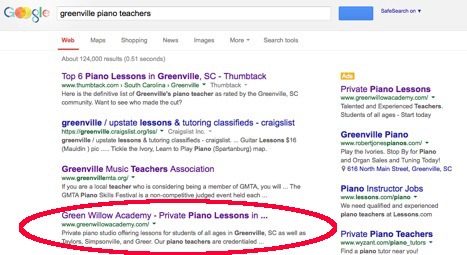
Search engines like Google make general suggestions for improving SEO, but do not offer specifics. It’s more of an art than a science, so I decided to focus on the top three recommendations made by self-help gurus.
First, I added “keywords” to my website. Keywords are informative terms used in search retrieval systems like Google and Yahoo. When someone initiates a search, search engines locate related keywords embedded in websites and attempts to reveal the most relevant search results that correspond to the keywords used in the search.
I added to my website more than thirty keyword phrases like “piano lessons,” “piano teachers,” “Greenville piano lessons,” and “piano lessons in Greenville, SC.”
Secondly, I increased the number of inbound links pointing to my website, another recognized technique for improving SEO. I added “www.greenwillowacademy.com” to every website or social media account I controlled, including my studio’s Facebook, LinkedIn and YouTube accounts, our Google Adwords campaigns, which already included it, and my studio blog and teacher directories.
I also began writing Facebook and blog posts that linked to my website as often as possible, typically once or twice a month.
Thirdly, I added succinct, keyword-packed phrases to page titles and page descriptions on my website. These included descriptions like “Green Willow Academy is a private piano studio offering lessons for students of all ages in Greenville, SC.” and “Our piano teachers are credentialed and experienced performers and pedagogues.”
Within a few weeks, our search result ranking went from the tenth page to the first page and we began receiving weekly new student requests. Periodically, I check up on our ranking and months later, we remain atop the local market.
I decided to include a mission statement on the front page of our studio website reflecting our philosophies as a music teacher co-operative and we officially began referring to our studio as a “Home Studio Co-operative of independent music teachers.”
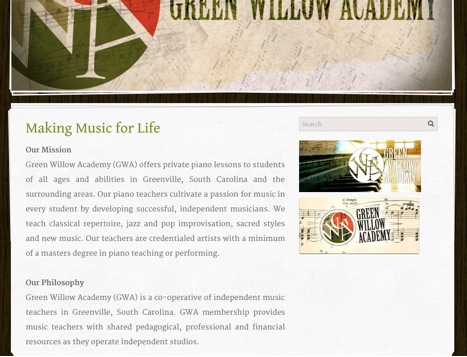
By the end of our first year, our expenses totaled $450, so we split them evenly, each paying $225. We soon added a voice teacher to our co-op, but in general we were very careful not to add more teachers than we could support.
We did not want the supply to out-strip the demand, so we determined from the beginning that new members would only be added if the following criteria were met: (1) if our current member’s teaching loads were relatively full, (2) if we believed we could effectively advertise and produce new student leads for the new member, and (3) if we all agreed on the new member.
Democratic decision-making and bottom-line, member success are chief tenets of co-operative business.
By the beginning of our second year, both the other piano teacher’s and my load were full. We still have new student requests every week, so we’re considering the addition of a third piano teacher.
We are passionate about empowering independent music teachers and helping them attain profitable and fulfilling careers, so we’re eager to begin searching for another, likeminded music teacher.
Other tasks for the upcoming year include a possible website design, SEO maintenance and Google Adwords campaigns to develop for next spring and summer. Our expected budget for the upcoming year is $600, less than 1% of any of our teachers’ annual earnings.
We believe co-operative business is good for independent music teachers, good for the industry and good for music students. Music teacher co-operatives are able to maintain more competitive tuition pricing than most community music schools because they don’t depend on the contract-teaching model.
Simply put, the more hands through which tuition passes, the less income for music teachers. The home studio co-operative model of music teaching has the benefits of music school-quality marketing, advertising, branding and organization, but none of the commission fees and contract agreements.
For music teachers seeking a home studio where there’s little to no financial risk or investment expense, the home studio co-operative may be just right.
The Music School Co-operative
The second type of music teacher co-operative utilizes the advertising, marketing, branding, organization and mission of the home studio co-op but includes shared studio space and equipment as an option for members.
It serves music teachers who desire a more professional studio space than a home studio or those who do not live in a location suitable for music teaching, such as an apartment with music teaching restrictions or a rural location too far from students.
Music school co-operatives already exist in the United Kingdom, Canada and Australia, to name a few. To my knowledge, there are no true music school co-operatives in the United States. The closest resemblance of one, that I am aware of, resides in Portland, Oregon.
The Music Studio on Harrison Hill in Portland is a quasi-music school co-operative founded by a church music director at Saint David of Wales Episcopal Church. The co-operative refers to their model as a “music education co-operative.”
It presently comprises six music teachers and offer lessons in a variety of instruments, including flute, piano, bassoon, clarinet, voice and violin.
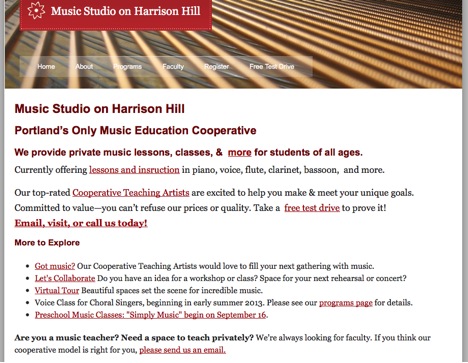
I recently spoke with the current director of Music Studio on Harrison Hill. He reported that their co-operative partners with Saint David of Wales Episcopal Church for the use of instruments and studio space at a low cost, less than $10 per hour for studio space. They also have the opportunity to participate in a work-trade program with their host church, providing music at services and events as well as helping in the church office when necessary to offset studio rental costs.
As a result, Harrison Hill teachers do not pay membership dues.
The director also said that Harrison Hill does not currently advertise except for a Craigslist ad and word-of-mouth. He said most of their new students come from the visibility of their studio location at the church.
Harrison Hill does have a website, created by the current director using a web-builder program. The website includes teacher biographies and photos, tuition information, program offerings, a registration application, and a virtual pictorial tour of the studio.
Harrison Hill’s mission statement reads:
We are not a music business but a cooperative of music teachers united to provide excellent music making experiences together. In fact, we prefer to call ourselves “Cooperative Teaching Artists” because we do so much more than teach. Each CTA commits to spending a fixed number of hours each month providing free music services to the community, volunteering with administrative tasks, or participating in professional development workshops. We also pool resources financially to share practice space and resources. The result: the hardest working team of highly qualified music teachers in town.
But allow me to propose a different version of a music school co-operative like Harrison Hill, but taken a step further in terms of advertising and marketing presence, and also different in relation to organizational structure and focus.
Imagine that a group of eight independent music teachers decide to establish a music school co-operative. Some of them desire the opportunity to work in a more professional studio environment while others need a better teaching location. They all wish to benefit from the shared pedagogical, professional, financial and business resources of a co-op.
The teachers decide to spend one year of preparation prior to opening. First, they determine a budget and next they begin searching for a commercial studio space. They also decide they will need to raise start-up capital for studio furnishings, equipment, pre-opening marketing and advertising, and remodeling.
The co-op members presently earn on average $30,000 net annual income. They decide to set a goal of contributing 10% each of their individual earnings towards start-up capital. After twelve months, their capital contributions total approximately $3,000 individually and $24,000 collectively.
Once a studio space has been determined, the co-op decides to spend $12,000 of their capital on studio furnishings like lobby and studio seating, lighting, desks, tables and bookshelves.
Next, they decide to spend $10,000 on studio remodeling, including reshaping the lobby are, creating viable studio space and constructing a kitchenette. They also spend $75 for website design using a professional business template from Wordpress, $75 for a domain name and twelve months of hosting, and $250 for graphic design work for logos, banners and print advertisements.
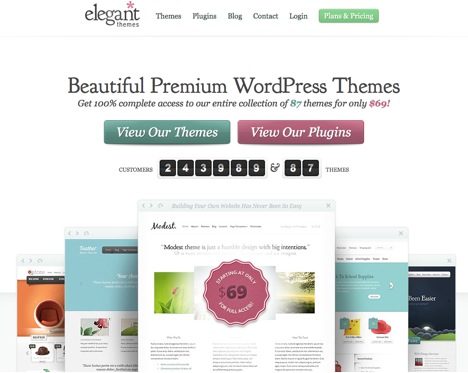
It is imperative that music studios acquire professional graphic and web design for logos, website banners and print ads. Trying to create quality branding for your music studio is not the time for experimentation with Photoshop, Paint or Microsoft Word Publisher.
It is essential that you hire a professional. In my case, the web designer whom I hired to design my website was also a graphic designer, as is commonly the case, so he created my logo, website banners, recital programs and print advertisements.
Most web builders do not offer graphic design services. Simply search online for graphic designers in your area, meet with one, tell him your budget and ideas, and get the process started. It’s not difficult and it shouldn’t be expensive.
Next, the co-op decides to join two teacher directories, Thumbtack.com, which is free, and LessonRating.com, which costs about $60 annually. They also set a monthly budget of $100 for Google Adwords to be used for three months prior to opening, costing a total of $300.
Their graphic designer creates flyers to be sent to nearby home school co-operatives, public schools and music stores. This costs $350 for design and printing.
In the end, the co-op’s pre-opening advertising and marketing expenses total $1,110. They spend the remaining start-up capital of $890 on studio Internet, WI-FI, a refrigerator, office supplies and a coffee maker. Co-op members are reimbursed with any remaining capital.
Before the co-op can begin, members must determine instrument procurement for their studio space. All non-piano teachers bring their own instrument for teaching, but piano teachers must have a piano in the studio. Piano teachers can either bring their own keyboard or piano from home or purchase one independently.
As the year of preparation comes to a close and the first official year of business begins, the co-op’s monthly expenses are projected to total $2,200. That includes $1,850 for studio rental, $100 for WI-FI and Internet, $100 for insurance, $200 for utilities and $50 for Google Adwords.
The co-op elects to pay one member $100 per month for the management of studio administration, marketing and advertising. The co-op also decides member contributions should be $325 per month, an average of 13% of each teacher’s individual monthly earnings, equaling $2,600 per month collectively.
By the end of the first year, advertising, marketing and referral efforts produce forty new students, an average of five new students per teacher, meaning an average of $5,000 in additional income per teacher.
With this in mind, the co-op decides to keep member contributions at $325 per month for the second year. Thanks to additional students, $325 per month for dues now equals 11%, not 13%, of most teachers’ monthly income.
Moving forward, the co-operative determines that if new members join, they must agree to a minimum of one year with the co-op. The co-op also agrees to allow new members who teach from home to join the co-operative, in which case they contribute only to co-op advertising and marketing, not to rent and building expenses.
The co-op also decides that new members, meaning non-founding members, must pay a one-time buy-in of $300. This money goes towards the reimbursement of founding members for their $3,000 contributions towards start-up capital.
Once all capital contributors have been reimbursed, the buy-in amount can either remain, change or be eliminated. In the case of the buy-in remaining, the cache can go towards studio improvements or delegated in whatever way the co-op deems helpful.
Throughout the following years, the co-op may continue fluctuating as new members join and others leave. Adjustments are made to monthly contribution amounts with constant attention being paid to solvency, fairness and meeting the needs of co-op members.
Ultimately, the co-operative can be dissolved at any time, or ideally, it may dissolve once all founding members have been reimbursed for their capital contributions.
The “X” Factor
A music teacher co-operative can only be as successful as it is able to produce effective and affordable advertising. The “X” factor for success is not necessarily an individual with business acumen, but rather an individual who can effectively implement rudimentary advertising techniques like those listed in this article.
For example, building, or having built, a website for your music teacher co-operative or music studio is essential. Easy to use resources like GoDaddy provide domain names and hosting.
Web builders like Square Space, Volusion, and Moonfruit, provide professional and affordable templates for web design. Improving website SEO only involves a bit of research and trial and error.
Creating a Google Adwords campaign is also a simple process, and joining teacher directories like Thumbtack and LessonRating, among others, will also extend your co-op’s advertising reach.
Establishing a social media presence for your studio using resources like LinkedIn, Facebook and Twitter will also effectively advertise your co-operative, build connectivity with parents and help build a studio brand.
Print advertisements are also relatively easy to develop. Find a graphic designer and work with him to design an ad that reaches your audience.
Remember that the primary function of music teacher co-operatives is to provide effective advertising and marketing for its members.
The techniques already mentioned are intended for small business owners just like music studio owners, making it easy, affordable and effective.
Summary
Never has there been a better time to begin an independent music-teaching career. The availability, effectiveness and affordability of small business resources make realizing a fulfilling and profitable music teaching career more of a reality today than ever before.
Still, many music teachers suffer from underemployment or low wages, or they decide to abandon the industry altogether. Others struggle to implement effective marketing and advertising techniques or to utilize technology like web builders and social media.
In some cases, music teachers cannot teach from their homes simply for lack of space. Other times, they simply do not live in locations suitable for operating a home studio, perhaps because they live in an apartment or they live too far away from potential students.
Music teacher co-operation provides answers to these problems and more. The co-operative model is already in use around the world, assisting and empowering music teachers through shared professional, pedagogical and financial resources.
The home studio co-operative offers maximum growth potential for music teachers, while affording the least financial commitment and investment risk. This type of co-op supports independent music teachers as they teach from home while providing them with advertising and marketing, purchasing power, unified branding and professional support.
The music school co-operative, on the other hand, helps independent music teachers in need of a brick-and-mortar studio environment. It provides the same level of branding, marketing, advertising and organization, but with side-by-side collegiality and the professionalism of a traditional music school environment.
In both types, music teachers determine contribution amounts and fund allocation, govern growth and expansion, and regulate new student-dispersion.
Members may contribute as little as 1% of their annual earnings in a home studio co-operative or between 10 and 20 percent on average in a music school co-operative. The savings are substantial, the opportunities are vast and the profit potential maximized.
I believe the best pathway to success for many independent music teachers is through a home studio co-operative, where costs are mitigated, investment risks are next to nothing, yet profit potential and autonomy are at the highest.
Music school co-operatives incur considerably higher contribution amounts, require more members to make it work, and involves a level of investment risk similar to opening a small business. It can be done successfully, but profit margins are lower than the home studio model and investment risks, higher.
In any case, it’s time for music teachers to start investing in themselves, not someone else. It’s time for music teachers to flourish in the industry, not as pawns in a contract-teaching model but as self-employed professionals. Music teacher co-operatives can make it possible.


